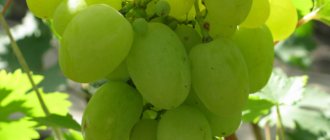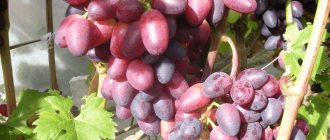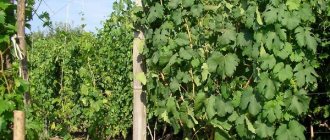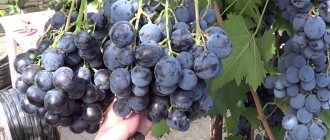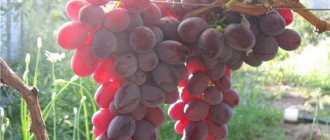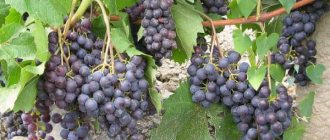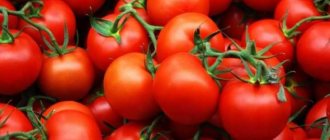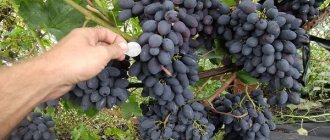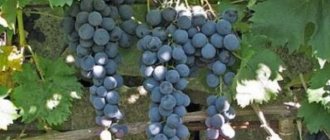A little about variety selection
This elite white grape was the result of breeding work by Russian scientists at VNIIViV named after. ME AND. Potapenko, who during its creation took into account the climatic features of the territories located in the middle latitudes of the country, which are unfavorable for growing many varieties of plants. The purpose of the experiments was to breed high-fruiting crops that are resistant to frost and damage from dangerous diseases.
The variety appeared thanks to the crossing of forms SV 12-309 with Kazachka and Amursky with Lyana. The breeding number assigned to it is 2-6-2.
Website about the dacha
02/03/2019 admin Comments No comments
If previously many were sure that grapes could only be grown in the south, now changeable weather is not a problem. There are many varieties that do well even with a sharp drop in temperature. Among them are Moscow white grapes, which are chosen by summer residents living in areas with a changeable climate. This is an early frost-resistant variety that, with proper care, will produce a good harvest. The berries are suitable both for food and for making wine. Most often, this early variety can be found on the plots of residents of the Moscow region.
Moscow white grapes are resistant to climatic conditions
This grape has many advantages: it is frost-resistant, winter-hardy, and early. The disadvantages include the fact that the berries of this variety are medium in size and have pits. In addition, these grapes are not very disease resistant.
General characteristics of the variety
| Purpose of the variety | universal |
| Bunch shape | elongated, flat |
| Bunch weight | 500 - 900 g |
| Berries shape | rounded |
| Berry weight | 6 g |
| Berry color | white-green to yellowish-white |
| Frost resistance of the variety | up to - 32 ºС |
| Taste | fruity sweetness with sourness |
An elite grape variety, the very name of which reflects the key features of its fruit, Maxi White is distinguished by its early ripening period. Full ripening and fruiting of the vine occurs, depending on the climatic conditions of the region where it grows, towards the end of August or beginning of September. The ideal time for harvesting is considered to be the middle of the first autumn month.
The bushes of the variety are characterized by average growth vigor; they reach full maturity 4-5 years after planting in a permanent place. Taking into account the peculiarities of the formation of adult plants, when planting seedlings, a distance of at least 1-2 m should be left between them so that as they grow they do not interfere with each other’s development.
The upper part of the shoot is open, rich green in color, with slight pubescence. Young leaves are colored bright green. They are bare, dissected into three lobes, the upper notches are not very deep. As they develop, the size of the leaves increases, they acquire a funnel-shaped shape, elongated along the median vein, and become five-lobed, medium-dissected. The depth of the upper cuts can be either shallow or medium. The lower notches stand out faintly. The leaves are heavily indented along the edges with non-sharp teeth that differ in height. The edges of the teeth are smooth, the base is wide. The bottom of the petiole notch is sharp. The length of the petiole most often coincides with the length of the midrib, but may be slightly shorter than the latter.
This variety produces rather large elongated clusters, distinguished by a noble, even shape. Their average weight is 500-900 g, but giant specimens weighing more than 1 kg are also quite common. The clusters are medium dense, they are strewn with berries that impress even experienced winegrowers with their large size. They have a round shape, are attractive in appearance, causing a desire to immediately taste their taste. Typically the berry weighs about 6 g and can be up to 5 cm in diameter.
The variety is characterized by fruits that have a greenish-white or yellowish-white color. Their flesh is dense, fleshy, juicy, and produces a characteristic crunching sound when eaten. On top it is covered in a soft, but at the same time quite durable, crispy skin that is easily eaten. This grape variety has very high taste qualities. Its berries have a pleasant, but not cloying sweetness that is harmoniously set off by a light, almost imperceptible sourness. The taste is complemented by delicate fruity notes.
The grapes are characterized by high productivity; up to 50 kg of juicy berries can be harvested from one plant.
How to plant Maxi white grapes
White super grapes grow on strong bushes. Its chemical and taste properties ensure successful implementation.
The vine bears fruit early. In mid-August in some regions it is already possible to harvest the first harvest. The weather in the cultivation region affects the timing of the mass harvest. The bushes mature to full strength within 4 – 5 years. The leaves are bright green in color, slightly dissected, glabrous with medium teeth along the edge.
The taste of berries has a barely noticeable sourness, a bright fruity bouquet, and is moderately sweet. The color of the soft skin is yellowish. The flesh is crispy and dense.
The owners do not note any shortcomings. Advantages worthy of attention:
- favorable presentation, excellent quality of berries;
- guaranteed large fruits;
- high resistance to frost, the vine easily tolerates cold -32°C;
- harmonious combination of sweetness and acidity in taste;
- it is stored for a long time, does not lose nutritional value and aroma;
- white is a problem-free variety during transportation.
Compliance with agrotechnical requirements, a little work, and the expectation of good harvests will be grateful.
Maxi white grapes produce beautiful large clusters
The distance between plants should be less than a meter. It is desirable that you have joy from good harvests.
The characteristic botanical features of this grape are as follows:
- The leaves of the plants are large, bright green in color, five-lobed, glabrous, and have a slight dissection. Along the edge of the leaf there are mild, medium-sized teeth.
- The brushes are elongated and dense. The weight of one bunch can reach 1 kg. The berries are juicy, sweet with a pleasant sourness and fruity aroma, covered with a dense, crispy skin of a soft green or yellow-green hue. They have an oval shape. The berries are large and can reach 5 centimeters in diameter.
This variety belongs to the category of early ripening grapes. The vine ripens and begins to bear fruit at the end of August, but mid-September is considered the best time to harvest. The yield is high, the weight of berries collected from one bush can reach 50 kg. The bushes are of medium vigor; maturation of the bush to full vigor is from 4 to 5 years. The optimal distance between seedlings is 1-2 m. It has good frost resistance - it can tolerate temperatures from -24 to -27 degrees. Resistance to fungal diseases and pests is average.
This variety is mainly grown for fresh sale. Despite its high taste, it is rarely used for making wine. Thanks to its dense skin, the grapes tolerate transportation well. The berries retain their beneficial qualities and presentation for a long time when stored.
Advantages and disadvantages of the variety
The grapes of the hybrid form Maxi white have no significant disadvantages, at the same time, the description of the advantages of the variety will be very extensive. Its main advantages are:
- Consistently high fruiting.
- Guaranteed large berry sizes, independent of changing weather conditions. The variety does not show a tendency to peas.
- Very attractive appearance of the bunches and excellent technical qualities of the berries, allowing these white grapes to be grown for sale.
- High frost resistance of the variety: its bushes are able to withstand cold temperatures down to -32C without consequences for their development and fruitfulness, due to which the distribution area of this hybrid is quite wide, it can be grown in the middle zone, and not only in the southern latitudes.
- Excellent taste characteristics of berries, combining a fine balance of sugar and acidity with the presence of exquisite fruit notes in the aftertaste.
- Resistance of berries to transportation.
- Possibility of long-term storage of fruits, during which their taste properties do not deteriorate and their presentation is not lost.
Features of cultivation
This white grape is quite unpretentious and does not require much time and effort to care for. The variety is hardy. Its resistance to fungal infections and garden pests is at an average level.
To increase fruiting, experienced winegrowers recommend regular pruning of the vine into 4-6 buds. The optimal load of eyes on one grape bush varies between 18-20. Cuttings have good rooting ability. The variety grows well with rootstocks when grafted in different ways.
About grapes
The frost-resistant variety is early and universal, because ripens in 115 days. This grape is not grown on an industrial scale, but this variety is popular among summer residents and gardeners.
History of creation
Moscow White was created at the station named after. P.G. Shita of the Timeryazev Academy. Experienced breeders K.P. took part in its creation. Skuin and E.N. Gubin. This variety was bred from two other magnificent varieties: the white Amur, which is also resistant to cold, created in Komsomolsk, and the white Zhemchug Saba, whose distinctive feature is its very early ripening.
Rules for planting and care
When purchasing planting material, you need to carefully examine the root system of the seedlings. It must be well developed. Only absolutely healthy plants that have no signs of infection and are not damaged by pests are suitable for planting.
When planting white grapes, you must adhere to a number of simple rules:
- the planting period lasts from the last ten days of March to the end of spring or from early autumn to mid-October;
- for grape plantings it is better to choose well-lit or semi-shaded areas;
- the required distance should be left between the planting holes;
- The planting depth is determined based on the volume of the root system of a particular seedling. The recommended depth is 50 cm.
Caring for planted plants includes preventive measures against infection by fungal diseases (mildew, oidium, gray mold) and pests, as well as regular, but in no case excessive, fertilization of the vineyard. To combat infections, spraying bushes with fungicides is effective. Regarding fertilizing, you should adhere to the following scheme: during the active growing season, the vines should be fertilized once every 10 days, using diluted mullein, superphosphate, and magnesium.
It is not for nothing that elite grape forms are in high demand among consumers and farmers. Everything speaks in their favor: large berries, high yield, resistance to adverse environmental influences, rapid ripening, rich taste. Domestic breeders managed to obtain a very worthy grape variety, which received well-deserved recognition and popularity among gardeners.
The plant is especially popular due to the fact that it belongs to elite varieties of plants, and is widely known not only in the territory of the former Soviet Union, but also far beyond its borders.
Planting
Maxi White grapes are recommended to be planted on dry slopes or hills that warm up well. This elite variety, according to reviews, does not tolerate heavy clay soil and lowlands. A place for grapes should be chosen with good lighting, preferably on the side where the sun shines.
Planting material should be carefully selected and seedlings that are weak and damaged should be discarded. It is necessary to examine the root system of young bushes. It must be well developed. Those grape seedlings that do not meet these requirements, or have a black coating, growths and damage, are not recommended to be planted.
The required distance between rows must be maintained. It should be approximately 4-5 meters. The bushes of the Maxi White variety themselves must be planted at a distance of at least 4 meters.
This is done according to the following scheme:
For planting, choose a place that is well lit by the sun from all sides.
For planting, choose a place that is well lit by the sun from all sides. There should be no access to this area for excess moisture and drafts.
A special small planting hole is dug. It should be slightly larger than the root system of the grapes. The recommended dimensions are 0.5 m by 0.2 m.
The soil dug out of the hole is mixed with complex and mineral fertilizers.
A small layer of gravel is poured onto the bottom (it will serve as drainage for the root system of grape seedlings). Planks or branches are laid on top.
A drainage pipe with a diameter of 8-10 cm is installed. It is necessary so that the plant can be watered through it.
A small mound is formed on top of the gravel and planks. It is made from pre-taken soil mixed with fertilizers.
The root system of the seedling is dipped into a specially prepared solution (one part of mullein, which has been rotted and two clays).
The shoots are cut off (no more than two buds) and dipped in pre-melted paraffin.
The young plant is placed in a hole; the root system should be straightened beforehand.
The dug hole with the seedling is filled with the remaining soil and compacted with careful movements.
After planting, Maxi White grapes are watered with warm water and mulched with rotted manure or compost.
Article on the topic: Fan formations - Pruning and shaping grape bushes
If these rules are followed correctly, you can achieve high yields on your site.
I have a large garden and vegetable garden, several greenhouses. I love modern methods of cultivating plants and mulching the soil, and I share my experience.
If there is a suitable place in the garden, but the soil is clayey, then you should add sand and peat to it, and then dig it well. In unsuitable soil conditions, you need to very carefully prepare the mixture with which the bush will be directly covered.
The root system should not only be well developed, but also healthy. First of all, carefully feel the spine. It should be flexible and resilient. If pieces fall off from it or simply fall apart in your hands, then rot has affected the roots. The cut should be light green, and under no circumstances brown.
If the purchase is made in a nursery, where they most often sell grape seedlings in closed containers, you need to look at the bottom of such a pot. It is important that the roots are visible through the drainage holes.
If this is not observed, then the seedling will probably die quickly after transplanting into the ground. This is due to the fact that it functions using nutrients from the stem. When they run out, the plant will die.
The seedling should first be kept in water to which root growth stimulants have been added. Duration 2 days.
It is better to make the planting hole a little larger. Approximate size - 70 centimeters in depth, width and height. Proportions of half a meter are suitable for very small seedlings. A well-prepared hole will significantly affect the harvest.
The mixture with which you need to fill the hole includes several buckets of organic matter, half a kilogram of nitroammophoska and the same amount of ash. All this must be thoroughly mixed and placed on top of the drainage. Then, a layer of just soil is laid out so that about 20-25 centimeters remain to the ground level.
It is necessary to take into account that the soil may shrink and then you will have to add it under a young bush. To prevent this from happening, it is worth preparing the landing site in advance. We would like to draw your attention to the fact that the mulch layer should be 7-8 centimeters so that moisture and heat are well retained.
While watching the video you will learn about growing elite grapes.
If several bushes of this plant are planted at once, the rule should be taken into account that the grape seedlings are located from the south to the north.
Noticed a mistake? Select it and press Ctrl+Enter to let us know.
general information
The Maxi White variety has found application in the field of winemaking.
The purpose of Maxi White is universal.
This means that from the berries of this variety you can make aromatic white wines, eat the fruits fresh, and prepare various desserts and drinks . Most often, experienced winegrowers grow grapes for sale at the market or wholesale to restaurants and cafes, since taste qualities are extremely valued in the consumer market.
History of the variety
The stand about the variety took place at the “ Potapenko Research Institute ” in Russia. During breeding work, many components were taken into account - the characteristics of different climates, soil environment, susceptibility to pathologies. During the event, the Kazachka, Amursky, Lyana, and SV 12–309 varieties were used.
It is characteristic that the selection was carried out in two stages, as a result of which a new plant was obtained, distinguished by its own characteristics.
Characteristics and features
The average weight of a bunch reaches 1 kg.
Grapes ripen early, the plant maturity phase begins in the first half of the third summer month in the middle climate.
If the variety is grown in a southern climate, the maturity phase begins three weeks earlier - in mid-July. Accordingly, in the north, ripening will be delayed by twenty days. It is noteworthy that prolonged rains can delay the onset of fruiting .
Bushes
The bushes have average growth vigor.
Despite the fact that the variety belongs to the elite, the bushes are not distinguished by strong growth; on the contrary, the bush growth is quite average.
- But the vine of the plant ripens quite early , which is explained by the minimum growing season.
- The brushes have a beautiful conical shape and almost no branching is recorded.
- Among other things, the clusters have a dense structure and no looseness was noticed.
- The average weight of a bunch is nine hundred grams, which suggests an increase in weight of up to one and a half kilograms if enhanced agricultural techniques are used.
Advantages
With good agricultural technology, the variety shows high yield and good endurance.
Elite varieties have virtually no drawbacks, but there are a number of points that require attention. The main advantages of the variety:
- earlier maturation;
- volumetric brushes;
- presentable;
- high degree of frost resistance;
- high taste qualities;
- transportability;
- long-term storage.
The frost resistance of the variety is quite high - about thirty-two degrees below zero. The plant requires shelter in northern climates and in the middle zone; in the south, only the roots can be covered. Experts rate the taste qualities of the variety at nine points.
and disadvantages
Some negative aspects of culture should be noted:
- susceptibility to powdery mildew;
- tendency to overload;
- uneven ripening;
- demands on watering;
- sensitivity to heat.
It cannot be said that the plant is very often infected with powdery mildew, but the immunity is rather weak against these infections.
At the first signs of powdery mildew, the grapes are treated with the fungicide Topaz, Vitaros or Arobat.
Grapes tend to reduce productivity if there is a large overload of vines and clusters , so standardization and pruning are necessary measures. Maxi White is a moisture-loving plant, but overwatering will lead to rotting of the roots, so strict control is needed.
An increase in temperature to thirty degrees can burn the green part , so the use of awnings over the bushes is recommended.
Features of cultivation and care
Seedlings must be free of signs of pests or diseases.
Despite its popularity, grapes are quite easy to care for, and even a novice gardener can cope with this, but the crop still requires some effort. The first rule of planting is a thorough inspection of the planting material.
The cuttings should not have any infectious lesions, cuts or scratches. They must be intact and have the characteristic color characteristic of young healthy plants.
Preparing the site
Standard planting hole for grapes.
- Recesses are dug for the seedlings, the dimensions of which are 80/80 cm , the distance between the bushes is 2.5 m .
- The support in the form of a peg for the vine is cut one and a half meters long - for tying up the regrown stems.
- The bottom of the hole is covered with drainage consisting of expanded clay, crushed stone or broken brick.
- Drainage is installed to prevent the influx of groundwater if it lies close to the soil surface.
Selecting a location
Grapes love the sun!
An important stage for planting is choosing a location for the future vineyard.
The terrain should be flat, located on the south or southwest side of the garden plot. It is necessary to eliminate the possibility of drafts and wind blown. It is permissible to plant grapes in any way - wall, arbor, trellis method. It must be remembered that when using the wall method, it is necessary to retreat from the building by at least a meter. This is done in order to allow the plant to “breathe” freely, ventilate, and not create suffocation inside the bush.
Boarding time
Can be planted in spring and autumn.
It is advisable to prepare the holes in the fall and plant them in the spring . If this is not possible, planting should be done in the fall, then the hole should be left for two weeks to reduce the aggressive reaction of fertilizers. After two weeks you can start planting.
A mound is formed in the center of the hole, a cutting is placed on it, and the roots are straightened along the perimeter of this mound. The first layer is poured very carefully, so as not to damage the roots, and watered.
“Maxi White” grapes belong to elite varieties that are widely used in winemaking and are also sold for fresh consumption.
Characteristics of the variety
Elite grape varieties require obtaining a harvest with excellent technical and quality characteristics. The “Maxi White” variety is most often grown for the purpose of sale. Mass harvesting occurs in August or September, depending on the region of cultivation and weather conditions.
Biological description and characteristics of berries
The bushes have average growth vigor. The vine is characterized by early fruiting. The main peak of fruiting occurs in mid-August. The bunch is formed large, beautifully leveled in shape, with high marketability. The standard weight of one bunch can vary from 500 to 900 g. Quite often, clusters reach a weight of 1 kg.
Harvest and storage
The variety is characterized by uniform ripening of berries within one fruit cluster, so harvesting is most conveniently done by cutting off whole bunches. A pruner or sharp knife is best for this. There are some rules for harvesting and storing grapes:
- choose a clear day for harvesting;
- the best time is in the afternoon, when the dew has dried;
- When picking, you should try to preserve the waxy coating on the berries as much as possible;
- the bunches are sorted by size and placed in boxes or baskets with the stem up;
- It is important to shade the harvested grapes from the sun;
- the optimal microclimate for storing fruits is temperature from 0 to +2 degrees, air humidity 80 - 90%;
- the storage should be dark;
- The bunches are stored hanging so that they do not touch each other.
Advice!
To store grapes for a period of no more than one month, wooden boxes can be used as containers. To do this, pour a layer of straw onto the bottom of the box and place the bunches in one layer, avoiding contact with each other.
Planting rules and cultivation features
At the stage of purchasing planting material, you should pay attention to ensuring that the seedlings have a high-quality and well-developed root system. The plant must be completely healthy and not have even the slightest signs of disease or pest damage.
The basic requirements for planting seedlings are as follows:
- planting should be carried out from the last ten days of March to May or from September to mid-October;
- the plant should be placed in a well-lit area, but it can also be planted in partial shade;
- it is very important to maintain a standard distance between planted plants, which can vary from one to two meters;
- The planting depth can vary depending on the volume of the seedling's root system; the standard depth is 50 centimeters.
The survival rate of seedlings is good. To obtain stable annual yields, the characteristics of the variety and the corresponding requirements for plant care should be taken into account:
- most often, the vineyard suffers from various diseases, as well as from an excess or deficiency of nutrients in the soil and exposure to adverse weather conditions;
- prevention against mildew is sprayed with fungicides such as 1% Bordeaux mixture, 0.4% solution of cuprosan or polychoma;
- to protect against oidium before flowering, vineyards should be treated with sulfur preparations, including colloidal sulfur or preparations such as Benleit, Topsin or Fundazol;
- gray rot, which affects the green mass of the grape bush, as well as berries and annual ripened shoots, can be removed using fungicides such as Benleit, Euparen and Topsin.
It is important to remember that in August, at the stage of harvest ripening, the use of chemicals is unacceptable. During this period, you can use colloidal sulfur, a pink solution of potassium permanganate, as well as soda ash and the drug "Actofit". When growing this variety, you should cut the vine into 4-6 buds, and also form a plant at the rate of 18-20 buds per bush.
Grapes belonging to table or universal varieties should be fertilized somewhat more often. During the growing season, the procedure is carried out every ten days using diluted mullein, superphosphate and magnesium.
Maxi black grapes: wine grapes for the northern regions
Purposeful work on breeding a variety suitable for the conditions of the middle zone gave the result in the form of Maxi black - a grape characterized by high fertility and frost resistance.
The variety is fertilized 3–4 times per season. Nitrogen fertilizers are used in the spring, potassium fertilizers in the summer, and phosphorus fertilizers in the fall. And also in the fall, the vineyard can be fertilized with compost.
Trimming
The pruning technology depends on the age of the shoots.
In spring, no more than 45 eyes are left on the bush. Autumn pruning is necessary to remove all damaged branches and leaves, as well as dried vines.
However, as a preventive measure, fungicides can be sprayed 2-3 times a season to prevent the spread of mildew or oidium.
The scourge of the variety is phylloxera or grape aphid. When infected with this pest, it is almost impossible to cure the bush. For preventive control of insects, the drugs “Confidor”, “Fastak” and “Bi 58” are used. Soap and tobacco solutions, infusions of ash or citrus peels are used as folk remedies.
Reviews from winegrowers
Winegrowers relatively recently began cultivating the “Maxi White” variety, and its seedlings can rarely be found on the market. The number of reviews is still small, but they are all positive. This variety is in consistently high demand among consumers, which is due to high marketability and excellent taste of the grapes.
Negative reviews most often come from insufficiently competent or novice winegrowers who have little understanding of the technology of growing grapes and do not pay due attention to the requirements of agricultural technology for growing the variety.
